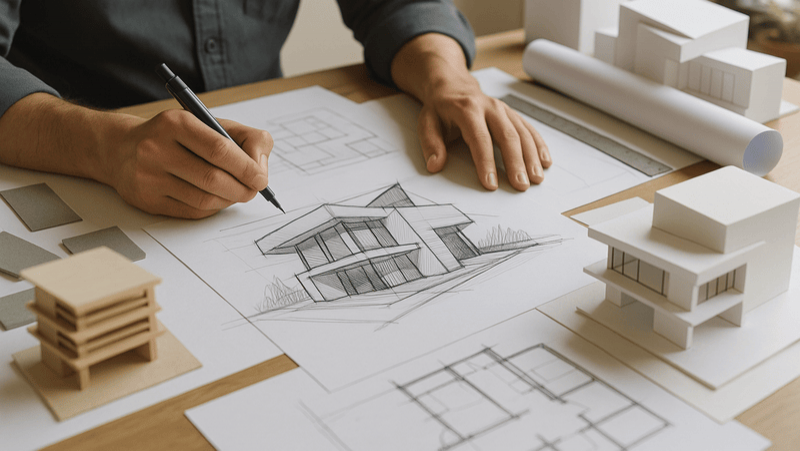When you picture a building project, it’s easy to imagine the finished product: a home alive with light, a workplace that supports productivity, or a café that attracts visitors. Yet behind every successful space lies the essential first stage—concept design. This early process shapes ideas into form, giving both architects and clients a clear direction before a single brick is laid.
What Is Concept Design and Why Does It Matter?
Concept design is more than sketching. It is a structured stage where abstract ideas become tangible, guiding the rest of the project. In architecture, this process involves translating a client’s needs, vision, and site conditions into practical possibilities. The way a building relates to its surroundings, the relationship between spaces, and even the impact of natural light are considered here.
Without a concept stage, projects risk misalignment between expectation and outcome. When carried out thoughtfully, it ensures feasibility, reduces costly changes later, and creates a shared vision for everyone involved. A strong example is Concept Design by Hutch Architecture, where architects collaborate closely with clients to balance creativity and practicality, ensuring the design reflects lifestyle, budget, and long-term goals.
Key Elements That Shape a Concept Design
A concept design draws from several overlapping considerations. The site is analysed to understand its opportunities and constraints, from topography and orientation to climate. The client’s brief then becomes the foundation for design decisions, outlining preferences, space requirements, and budget. From there, architects produce sketches and models to test ideas and visualise potential layouts. Material options may also be suggested early to give the project a sense of character, while sustainability is now an integral part of planning, ensuring buildings are efficient and environmentally responsible from the outset.
How Concept Design Shapes the Final Build
The impact of concept design is long-lasting. It not only sets the creative tone but also guides technical decisions in the detailed design, approvals, and construction phases. Identifying natural light paths early, for example, can influence window placement and reduce future energy costs. Considering local council regulations at this stage helps to prevent approval delays or redesigns.
Hutch Architecture has built its reputation on seamlessly weaving compliance and creativity together. For clients, this means fewer surprises, better communication across project teams, and a smoother transition from design to delivery. Choosing Hutch Architecture – expert in concept design provides peace of mind that imagination and practicality will work hand in hand.
The Role of Collaboration in Concept Design
Concept design thrives on collaboration. Clients, architects, and consultants all contribute to shaping the outcome. This dialogue ensures the design not only looks good but also works in practice. A family home, for instance, might begin with the client’s wish for open-plan living. Through discussion, adjustments could be suggested to improve ventilation or create private spaces where needed. The process is dynamic, testing possibilities until a design emerges that feels both functional and comfortable.
Concept Design for Different Project Types
The value of concept design applies to every project type, but the focus shifts depending on the goal. Homes often prioritise lifestyle, comfort, and harmony with the site. Commercial buildings highlight function, branding, and how people move through the space. Community projects may emphasise sustainability, accessibility, and the way they bring people together. Whatever the scope, professional concept design from Hutch Architecture adapts the process to suit, ensuring the design resonates with its intended audience.
Practical Benefits of Concept Design
Engaging with concept design early provides tangible benefits. It offers clarity of vision, showing what a project might look and feel like before construction begins. It saves costs by addressing potential issues when they are easiest to change. It improves communication across teams, with builders, engineers, and planners all working from a unified plan. Most importantly, it allows creativity to flourish while still maintaining control over practical constraints.
Building Sustainability Into the First Stage
As sustainability becomes a central part of architecture, concept design provides the ideal platform for integrating it from the beginning. Passive heating and cooling, natural lighting strategies, and water management solutions can be explored long before construction begins. Materials are considered not only for their aesthetics but also for their durability and environmental footprint. This forward-thinking approach benefits both the planet and the client, leading to lower running costs and spaces that remain comfortable and relevant well into the future. For broader perspectives on architecture and sustainability, resources such as ArticleSide’s design insights offer useful context.
How Clients Can Contribute
Clients play a critical role in concept design. Coming to the process with a clear sense of priorities helps guide decision-making. Some may emphasise sustainability, others may prioritise budget or aesthetic preferences. Collecting inspiration, such as photographs or sketches, can also help communicate ideas. Most importantly, clients benefit by being open to new suggestions—this flexibility often leads to innovative and satisfying outcomes. Further guidance on preparing for architectural projects can be found in ArticleSide’s project planning section.
Why Concept Design Should Never Be Skipped
Skipping this stage can compromise an entire project. Without a concept to anchor decisions, misunderstandings may arise, costs can escalate, and the final result may fall short of expectations. A carefully developed concept design reduces these risks and ensures that every subsequent stage flows more smoothly.
Final Thoughts
Concept design is the heartbeat of architecture. It turns ideas into form, balances imagination with feasibility, and sets a clear path forward. For clients, it offers the reassurance that their vision is achievable and their investment is protected. With guidance from experts such as Concept Design by Hutch Architecture, the process becomes an exciting collaboration that transforms ambition into reality.








